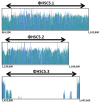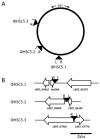Presence of a Prophage Determines Temperature-Dependent Capsule Production in Streptococcus pyogenes
- PMID: 27669311
- PMCID: PMC5083913
- DOI: 10.3390/genes7100074
Presence of a Prophage Determines Temperature-Dependent Capsule Production in Streptococcus pyogenes
Abstract
A hyaluronic acid capsule is a major virulence factor in the pathogenesis of Streptococcus pyogenes. It acts as an anti-phagocytic agent and adhesin to keratinocytes. The expression of the capsule is primarily regulated at the transcriptional level by the two-component regulatory system CovRS, in which CovR acts as a transcriptional repressor. The covRS genes are frequently mutated in many invasive strains, and a subset of the invasive CovRS mutants does not produce a detectable level of the capsule at 37 °C, but produces a significant amount of the capsule at sub-body temperatures. Here, we report that a prophage has a crucial role in this capsule thermoregulation. Passaging CovR-null strains showing capsule thermoregulation using a lab medium produced spontaneous mutants producing a significant amount of the capsule regardless of incubation temperature and this phenotypic change was caused by curing of a particular prophage. The lab strain HSC5 contains three prophages on the chromosome, and only ΦHSC5.3 was cured in all spontaneous mutants. This result indicates that the prophage ΦHSC5.3 plays a crucial role in capsule thermoregulation, most likely by repressing capsule production at 37 °C.
Keywords: Capsule thermoregulation; CovRS; Hyaluronic acid capsule; Prophages; Streptococcus pyogenes.
Conflict of interest statement
The authors declare no conflict of interest. The funding sponsors had no role in the design of the study; in the collection, analyses, or interpretation of data; in the writing of the manuscript, and in the decision to publish the results.
Figures




Similar articles
-
Thermoregulation of capsule production by Streptococcus pyogenes.PLoS One. 2012;7(5):e37367. doi: 10.1371/journal.pone.0037367. Epub 2012 May 17. PLoS One. 2012. PMID: 22615992 Free PMC article.
-
Capsular hyaluronic acid of equine isolates of Streptococcus zooepidemicus is upregulated at temperatures below 35°C.Equine Vet J. 2015 May;47(3):333-8. doi: 10.1111/evj.12272. Epub 2014 Jun 11. Equine Vet J. 2015. PMID: 24735124
-
CovRS-Regulated Transcriptome Analysis of a Hypervirulent M23 Strain of Group A Streptococcus pyogenes Provides New Insights into Virulence Determinants.J Bacteriol. 2015 Oct;197(19):3191-205. doi: 10.1128/JB.00511-15. Epub 2015 Jul 27. J Bacteriol. 2015. PMID: 26216843 Free PMC article.
-
Cell Wall and Surface Molecules of Streptococcus pyogenes: Capsule.2022 Jun 4 [updated 2022 Nov 30]. In: Ferretti JJ, Stevens DL, Fischetti VA, editors. Streptococcus pyogenes: Basic Biology to Clinical Manifestations [Internet]. 2nd edition. Oklahoma City (OK): University of Oklahoma Health Sciences Center; 2022 Oct 8. Chapter 4. 2022 Jun 4 [updated 2022 Nov 30]. In: Ferretti JJ, Stevens DL, Fischetti VA, editors. Streptococcus pyogenes: Basic Biology to Clinical Manifestations [Internet]. 2nd edition. Oklahoma City (OK): University of Oklahoma Health Sciences Center; 2022 Oct 8. Chapter 4. PMID: 36479757 Free Books & Documents. Review.
-
Cell Wall and Surface Molecules: Capsule.2016 Feb 10 [updated 2016 Mar 25]. In: Ferretti JJ, Stevens DL, Fischetti VA, editors. Streptococcus pyogenes: Basic Biology to Clinical Manifestations [Internet]. Oklahoma City (OK): University of Oklahoma Health Sciences Center; 2016–. 2016 Feb 10 [updated 2016 Mar 25]. In: Ferretti JJ, Stevens DL, Fischetti VA, editors. Streptococcus pyogenes: Basic Biology to Clinical Manifestations [Internet]. Oklahoma City (OK): University of Oklahoma Health Sciences Center; 2016–. PMID: 26866213 Free Books & Documents. Review.
Cited by
-
Hydrogen Peroxide Production of Group A Streptococci (GAS) is emm-Type Dependent and Increased at Low Temperatures.Curr Microbiol. 2019 Jun;76(6):698-705. doi: 10.1007/s00284-019-01683-y. Epub 2019 Apr 6. Curr Microbiol. 2019. PMID: 30955044
-
The Bacteriophages of Streptococcus pyogenes.Microbiol Spectr. 2019 May;7(3):10.1128/microbiolspec.gpp3-0059-2018. doi: 10.1128/microbiolspec.GPP3-0059-2018. Microbiol Spectr. 2019. PMID: 31111820 Free PMC article. Review.
-
Effects of artificial honey and epigallocatechin-3-gallate on streptococcus pyogenes.BMC Microbiol. 2022 Aug 26;22(1):207. doi: 10.1186/s12866-022-02611-0. BMC Microbiol. 2022. PMID: 36028794 Free PMC article.
References
-
- Dinkla K., Sastalla I., Godehardt A.W., Janze N., Chhatwal G.S., Rohde M., Medina E. Upregulation of capsule enables Streptococcus pyogenes to evade immune recognition by antigen-specific antibodies directed to the G-related α2-macroglobulin-binding protein GRAB located on the bacterial surface. Microbes Infect. 2007;9:922–931. doi: 10.1016/j.micinf.2007.03.011. - DOI - PubMed
-
- Schrager H.M., Alberti S., Cywes C., Dougherty G.J., Wessels M.R. Hyaluronic acid capsule modulates M protein-mediated adherence and acts as a ligand for attachment of group a streptococcus to CD44 on human keratinocytes. J. Clin. Investig. 1998;101:1708–1716. doi: 10.1172/JCI2121. - DOI - PMC - PubMed
LinkOut - more resources
Full Text Sources
Other Literature Sources
Miscellaneous

